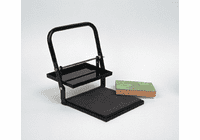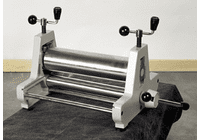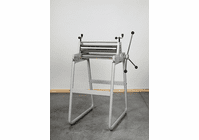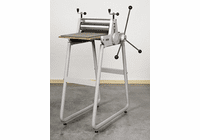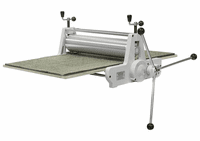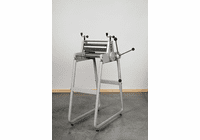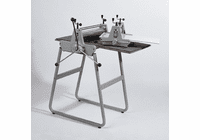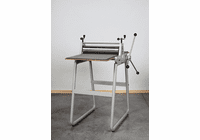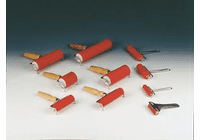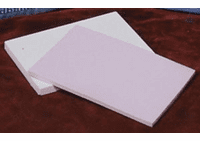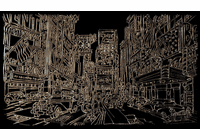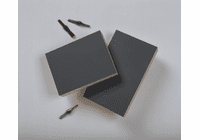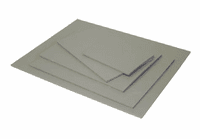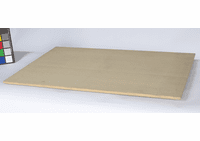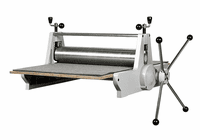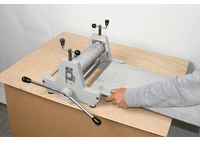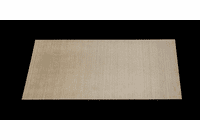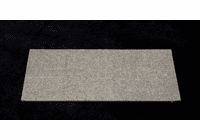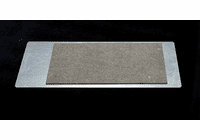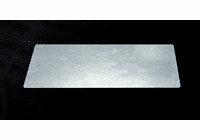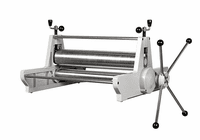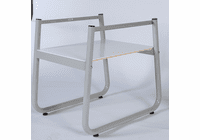Etching Press
 Etching Presses, Print Making Press also known as: manual printing presses, etching presses, fine art presses, intaglio printing presses, lithography presses, printmaking presses and woodblock printmaking.
Etching Presses, Print Making Press also known as: manual printing presses, etching presses, fine art presses, intaglio printing presses, lithography presses, printmaking presses and woodblock printmaking.Madison Art Shop has Complete Original Italian Fome Printing Press Packages and Parts
Richeson Artists' Manual Printing Presses are manufactured using quality parts and craftsmanship.
Take advantage now of the same top quality printing presses that professional printmakers work with to obtain the cleanest prints.
All About Etching
Etching is a technique that was developed in the 14th century as a way to decorate armor. The Italian term, “intaglio,” means to engrave or to cut into. In the 17th century, it was one of Rembrandt’s favorite techniques. With this technique, an image is incised, or cut, into a plate made from metal such as copper, zinc or steel. To prepare a metal plate for etching, it is first covered with wax, resin ground or some other substance that is acid resistant. To protect the plate from the acid, its back and sides are coated with a layer of varnish. With an etching needle, the artist cuts into the layer of resin to expose the metal beneath it, but without scratching into it.
The next step is to dip the plate into a tray of acid, so the acid will bite into the metal that is exposed by the needle’s scratches. The ink is held onto the plate by lines that have been eaten away by the acid. By playing around with different concentrations of acid and varying the time the plate is immersed, it is possible to manipulate the intensity and quality of the lines that are produced. It is also possible to put the plate into the acid successively, by drawing out only one area of the image at a time. In this way, the lines that were first drawn on the plate will end up being darker than those that are dipped into the acid last.
Although either a soft ground or a hard ground can be used to create an etching, the soft ground yields less resistance to the needle, so the line produced feels freer and can resemble a crayon or a pencil. When using hard ground, it is more difficult to produce good lines, so they are oftentimes thin and wiry with blunt ends.
Another type of etching is drypoint. Drypoint prints are also made by scratching the plate’s surface with a needle. This method creates a rough metal bur that will hold the ink. The lines created using the drypoint technique tend to be fuzzy and irregular. The bur is fragile, so the plate can only be used for an edition of around ten to twenty prints.
Aquatint, which is another type of ground, resists acid but doesn’t leave a solid coat of ink on the plate. It is made up of fine particles and works well for varying tones on a print. This process begins by dusting the plate with fine particles of rosin. To make the particles adhere, the plate is heated. This is followed up with a layer of tar or varnish on the sections outside the image. Then the plate is ready to be dipped in the acid. When the acid bites in around each grain of rosin, the varying tones are produced.
Spit bite aquatint is a technique that allows the acid to bite the plate in an uneven pattern. This happens by painting acid over the aquatint surface. It gives an appearance similar to that of a watercolor wash.
Another popular type of aquatint is called sugar lift. With this process, the image is produced by painting a layer of sugar solution directly onto the plate. After it dries, the sugar layer becomes sticky. Next, a hard wax ground is applied to the plate, which causes the sugar to dissolve. After that, the hard ground lifts away from the plate when it is immersed into water. The sections that are left exposed can then be aquatinted before the plate is printed. For a more delicate effect, it is possible to apply the aquatint before the sugar layer and hard ground.
[Writers note: The types of etching that I detailed are the forms of art these presses are used for. There are different types of etching, and I gave useful information about each type. This is what people who are interested in buying an etching press will want to know. They will want to understand that with these presses, they can produce fine quality etching using various techniques. It is definitely something that other sites or blogs can link to. My husband is a printmaker, and we actually own a large press. When we go to museums, he studies each piece carefully to determine what type of technique was used to produced each etching. I think that all artists do that - they check the size of the imprint the metal plate leaves, the way the edges are printed and what method was used for each... Gayla]
* * *
Richeson Artists' Manual Printing Presses are manufactured using quality parts and craftsmanship.
In most cases, if you reduce the overall size of the Etching press by 1 1/4 to 2 inches that will give you the the print size the press will handle.
All of our press's are made of Aluminum castings - very strong, yet lighter than cast iron and won't rust!
The bases are Tubular steel.
The Bed Plate: This will depend on the size:
The Baby Press comes only with a steel bed.
The Small comes with a choice of Steel or Phenolic. In lengths of 26" & 36" (both come with the gray cushion)
The Medium & Large are available with only a Phenolic bed.
(Phenolic is much lighter then steel yet very strong and won't rust - made of reinforced resin.)
All etching presses come with lathed solid steel rollers - size dependent on the press size.
Dual calibrated pressure adjustments for micro adjustments!
We stand behind all the products we sell!
RICHESON PROFESSIONAL PRESSES
An intaglio printing press built for professionals, Richeson Professional Presses are the best quality on the market. They feature rock solid, heavy castings, solid steel rollers, and micro pressure gauges. Priced for artists! Best sellers!
Printmaking
TIPS ON PRINTMAKING PRESSES:
Aligning Your Etching Press
How important is it to align a printing press?
Using a printing press that is not properly aligned will eventually render it useless. It is very important that your printing press is installed and aligned properly. If the rollers of your printing press are not positioned in a parallel position from end to end it will exert uneven force that will distort your art. One way to see if your press is aligned properly is to see if it will rock from side to side. If it does it is not properly aligned.
Printing Press Maintenance
How do you care for a printing press?
If you have purchased a an etching press or printing press then you know that it is no small investment. To ensure the life of your printing press you should clean it after each use and cover it with a dust free covering between uses. You should also make sure your press is dried thoroughly after it is washed to prevent rusting. You should also wipe down your press chains and rollers with oil.
Printmaking Techniques and Printing Presses
What types of printmaking utilize printing presses?
The term “printing press” is used to describe the mechanical device that is used to apply pressure onto a press bed in order to transfer an image. However, there are many different methods of printmaking and many different styles of presses.
Types of Printmaking
What are types of print making that require printing presses?
Curious about printmaking? If so, you should know that there are four types.
• Relief printing: This is the oldest form of printing. It works by using raised areas on a block of wood and inking it and pressing it onto a surface.
• Intaglio printing press: This style of printing is the same as etching. Ink is rubbed into grooves or crevices that have been dug out or eaten away with acid.
• Lithography: Originally this type of printmaking was done by drawing with an oily crayon on a stone. Today it is most likely drawn on aluminum.
• Silk screening: This type of printmaking s created by blocking out portions of a screen and squeezing ink through a thin cloth stretched across a frame.
Printing Press
The printing press was originally invented in 1450, by Johann Gutenberg for the printing of texts. This apparatus literally squashes the printing block and the paper together, thus transferring the image from the one to the other. Usually the artist lays the paper on top of the inked block or matrix, and introduces it into the printing press. The artist turns a wheel to adjust the pressure squeezing the block tightly against the paper, transferring the ink from block to paper.
These are used today as an art-form, (as opposed to modern electric commercial offset printing presses.)
These Print Making Presses are also known as "etching presses."
The Intaglio Printing Press is used in conjunction with linoleum. The artist carves out an outline on the linoleum, then places a piece of paper on top of the lino, and then turns the handle. The handle in turn feeds the movable bed under the roller to press the roller and the paper covered lino to form the print!
An intaglio printing press can be used for wood block printing or linoleum.
* * *
New Presses

Shown: Medium (#695301) and Baby Press (#695100)
#695100 Baby Press Package Includes
Blanket and Plate
Roller is 10 3/4” in length and is a 3” diameter solid steel roller. There are two leveling devices on the press for accurate settings. Handles are ergonomically constructed for ease of rotation. Ideal for etching, greeting cards, embossing and unmounted linoleum printing.
Print size: 9 ½” x 18"
Steel plate: 1/8" thick, 11.75" x 19.75"
Felt: 10.5" x 19" x ¼” Gray Cushion Blanket
Upper roll: 3" diameter, 10.75" long (solid steel)
Lower roll: 1.5" diameter, 10.75" long (solid steel)
Base dimensions: 13.25" x 11.75" (width doesn’t include turning wheel)
Total Clearance 15/16”
Ships via UPS 70 lbs.
#695301 Medium Press Package Includes
Medium Stand
Blanket and Plate
Roller is 19” in length and is a solid steel roller. There are two leveling devices on the press for accurate setting. Handles are ergonomically constructed for ease of rotation. Ideal for etching, greeting cards, embossing and unmounted linoleum printing.
Print size: 17" x 35"
Phenolic plate: 1/2" thick", 19 5/8” x 36"
Felt: 18" x 36" x ¼” Gray Cushion Blanket
Upper roll: 4.5" diameter, 19" long (solid steel)
Lower roll: 2" diameter, 19" long (solid steel)
Working height: 34.25" with stand
Base dimensions: 21.5" x 30" (width does not include turning wheel)
Total Clearance at least 1 1/4 “
Full cradle return spring
Aluminum side castings, predrilled for attaching to the stand.
Weight 235 lbs.
Medium Press Stand
H: 34 ¼” W: 21 ½” D: 30” Weight 15 lbs.
#695401 Large Press Package Includes
Large Stand
Blanket and Plate
Roller is 22 ¾” in length and is a solid steel roller. There are two leveling devices on the press for accurate setting. Handles are ergonomically constructed for ease of rotation. Ideal for etching, greeting cards, embossing and unmounted linoleum printing.
Print size: 22" x 35"
Phenolic plate: 1/2" thick", 23 5/8" x 36"
***
When in New York City, visit the New York Soceity of Etchers Invitational Exhibit at the Transit Museum, Grand Central Station, NYC, for Printmaking Etching, etching and acquatint exhibits!
(Printing Presses, art printing presses, hand printing presses, printing press packages & printmaking.)
***
Manual Printing, Etching , Fine Art, Intaglio Printing, Lithography, Printmaking, and Woodblock Printmaking PRESSES
From detailed customized newsletters to creative flyers, get your projects etched and printed using one stop shopping for all your printing needs.
Crafting is very popular today. Many people prefer to invest in equipment to make their cards, newsletters, flyers and more. Making an investment in your own printing machine opens the possibilities for endless crafting and hobby projects. Printing presses vary in size and ability. At Madison Art Shop there is a variety of printing presses available. This allows you to get what you need and want in a printing press.
Your basic manual printing machine includes features such as etching, intaglio printing, and lithography. These features deliver style and character to your work of art. If your hobby is greeting cards and scrap booking the etching feature is a must have. Embossing text and objects has never been easier with woodblock printing presses. Printmaking gives the artist and craft maker freedom to take their hobby to the next level.
Etching is a technique that was developed in the 14th century as a way to decorate armor. The Italian term, “intaglio,” means to engrave or to cut into. In the 17th century, it was one of Rembrandt’s favorite techniques. With this technique, an image is incised, or cut, into a plate made from metal such as copper, zinc or steel. To prepare a metal plate for etching, it is first covered with wax, resin ground or some other substance that is acid resistant. To protect the plate from the acid, its back and sides are coated with a layer of varnish. With an etching needle, the artist cuts into the layer of resin to expose the metal beneath it, but without scratching into it.
The next step is to dip the plate into a tray of acid, so the acid will bite into the metal that is exposed by the needle’s scratches. The ink is held onto the plate by lines that have been eaten away by the acid. By playing around with different concentrations of acid and varying the time the plate is immersed, it is possible to manipulate the intensity and quality of the lines that are produced. It is also possible to put the plate into the acid successively, by drawing out only one area of the image at a time. In this way, the lines that were first drawn on the plate will end up being darker than those that are dipped into the acid last.
Although either a soft ground or a hard ground can be used to create an etching, the soft ground yields less resistance to the needle, so the line produced feels freer and can resemble a crayon or a pencil. When using hard ground, it is more difficult to produce good lines, so they are oftentimes thin and wiry with blunt ends.
Another type of etching is drypoint. Drypoint prints are also made by scratching the plate’s surface with a needle. This method creates a rough metal bur that will hold the ink. The lines created using the drypoint technique tend to be fuzzy and irregular. The bur is fragile, so the plate can only be used for an edition of around ten to twenty prints.
Aquatint, which is another type of ground, resists acid but doesn’t leave a solid coat of ink on the plate. It is made up of fine particles and works well for varying tones on a print. This process begins by dusting the plate with fine particles of rosin. To make the particles adhere, the plate is heated. This is followed up with a layer of tar or varnish on the sections outside the image. Then the plate is ready to be dipped in the acid. When the acid bites in around each grain of rosin, the varying tones are produced.
Spit bite aquatint is a technique that allows the acid to bite the plate in an uneven pattern. This happens by painting acid over the aquatint surface. It gives an appearance similar to that of a watercolor wash.
Another popular type of aquatint is called sugar lift. With this process, the image is produced by painting a layer of sugar solution directly onto the plate. After it dries, the sugar layer becomes sticky. Next, a hard wax ground is applied to the plate, which causes the sugar to dissolve. After that, the hard ground lifts away from the plate when it is immersed into water. The sections that are left exposed can then be aquatinted before the plate is printed. For a more delicate effect, it is possible to apply the aquatint before the sugar layer and hard ground.
[Writers note: The types of etching that I detailed are the forms of art these presses are used for. There are different types of etching, and I gave useful information about each type. This is what people who are interested in buying an etching press will want to know. They will want to understand that with these presses, they can produce fine quality etching using various techniques. It is definitely something that other sites or blogs can link to. My husband is a printmaker, and we actually own a large press. When we go to museums, he studies each piece carefully to determine what type of technique was used to produced each etching. I think that all artists do that - they check the size of the imprint the metal plate leaves, the way the edges are printed and what method was used for each... Gayla]
* * *
Richeson Artists' Manual Printing Presses are manufactured using quality parts and craftsmanship.
In most cases, if you reduce the overall size of the Etching press by 1 1/4 to 2 inches that will give you the the print size the press will handle.
The Baby Press comes only with a steel bed.
The Small comes with a choice of Steel or Phenolic. In lengths of 26" & 36" (both come with the gray cushion)
The Medium & Large are available with only a Phenolic bed.
(Phenolic is much lighter then steel yet very strong and won't rust - made of reinforced resin.)
RICHESON PROFESSIONAL PRESSES
An intaglio printing press built for professionals, Richeson Professional Presses are the best quality on the market. They feature rock solid, heavy castings, solid steel rollers, and micro pressure gauges. Priced for artists! Best sellers!
Printmaking
TIPS ON PRINTMAKING PRESSES:
Aligning Your Etching Press
How important is it to align a printing press?
Using a printing press that is not properly aligned will eventually render it useless. It is very important that your printing press is installed and aligned properly. If the rollers of your printing press are not positioned in a parallel position from end to end it will exert uneven force that will distort your art. One way to see if your press is aligned properly is to see if it will rock from side to side. If it does it is not properly aligned.
Printing Press Maintenance
How do you care for a printing press?
If you have purchased a an etching press or printing press then you know that it is no small investment. To ensure the life of your printing press you should clean it after each use and cover it with a dust free covering between uses. You should also make sure your press is dried thoroughly after it is washed to prevent rusting. You should also wipe down your press chains and rollers with oil.
Printmaking Techniques and Printing Presses
What types of printmaking utilize printing presses?
The term “printing press” is used to describe the mechanical device that is used to apply pressure onto a press bed in order to transfer an image. However, there are many different methods of printmaking and many different styles of presses.
Types of Printmaking
What are types of print making that require printing presses?
Curious about printmaking? If so, you should know that there are four types.
• Relief printing: This is the oldest form of printing. It works by using raised areas on a block of wood and inking it and pressing it onto a surface.
• Intaglio printing press: This style of printing is the same as etching. Ink is rubbed into grooves or crevices that have been dug out or eaten away with acid.
• Lithography: Originally this type of printmaking was done by drawing with an oily crayon on a stone. Today it is most likely drawn on aluminum.
• Silk screening: This type of printmaking s created by blocking out portions of a screen and squeezing ink through a thin cloth stretched across a frame.
Printing Press
The printing press was originally invented in 1450, by Johann Gutenberg for the printing of texts. This apparatus literally squashes the printing block and the paper together, thus transferring the image from the one to the other. Usually the artist lays the paper on top of the inked block or matrix, and introduces it into the printing press. The artist turns a wheel to adjust the pressure squeezing the block tightly against the paper, transferring the ink from block to paper.
These are used today as an art-form, (as opposed to modern electric commercial offset printing presses.)
These Print Making Presses are also known as "etching presses."
The Intaglio Printing Press is used in conjunction with linoleum. The artist carves out an outline on the linoleum, then places a piece of paper on top of the lino, and then turns the handle. The handle in turn feeds the movable bed under the roller to press the roller and the paper covered lino to form the print!
An intaglio printing press can be used for wood block printing or linoleum.
* * *
New Presses

Shown: Medium (#695301) and Baby Press (#695100)
#695100 Baby Press Package Includes
Blanket and Plate
Roller is 10 3/4” in length and is a 3” diameter solid steel roller. There are two leveling devices on the press for accurate settings. Handles are ergonomically constructed for ease of rotation. Ideal for etching, greeting cards, embossing and unmounted linoleum printing.
#695301 Medium Press Package Includes
Medium Stand
Blanket and Plate
Roller is 19” in length and is a solid steel roller. There are two leveling devices on the press for accurate setting. Handles are ergonomically constructed for ease of rotation. Ideal for etching, greeting cards, embossing and unmounted linoleum printing.
Medium Press Stand
H: 34 ¼” W: 21 ½” D: 30” Weight 15 lbs.
#695401 Large Press Package Includes
Large Stand
Blanket and Plate
Roller is 22 ¾” in length and is a solid steel roller. There are two leveling devices on the press for accurate setting. Handles are ergonomically constructed for ease of rotation. Ideal for etching, greeting cards, embossing and unmounted linoleum printing.
***
When in New York City, visit the New York Soceity of Etchers Invitational Exhibit at the Transit Museum, Grand Central Station, NYC, for Printmaking Etching, etching and acquatint exhibits!
(Printing Presses, art printing presses, hand printing presses, printing press packages & printmaking.)
***
Manual Printing, Etching , Fine Art, Intaglio Printing, Lithography, Printmaking, and Woodblock Printmaking PRESSES
From detailed customized newsletters to creative flyers, get your projects etched and printed using one stop shopping for all your printing needs.
Crafting is very popular today. Many people prefer to invest in equipment to make their cards, newsletters, flyers and more. Making an investment in your own printing machine opens the possibilities for endless crafting and hobby projects. Printing presses vary in size and ability. At Madison Art Shop there is a variety of printing presses available. This allows you to get what you need and want in a printing press.
Your basic manual printing machine includes features such as etching, intaglio printing, and lithography. These features deliver style and character to your work of art. If your hobby is greeting cards and scrap booking the etching feature is a must have. Embossing text and objects has never been easier with woodblock printing presses. Printmaking gives the artist and craft maker freedom to take their hobby to the next level.
Copyright © 2002- Madison Art Shop™ LLC. All Rights Reserved.

